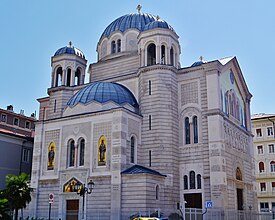Saint Spyridon Church, Trieste
| Saint Spyridon Church, Trieste | |
|---|---|
| Црква светог Спиридона Crkva svetog Spiridona Chiesa di San Spiridione | |
 Saint Spyridon Church | |
 | |
| Location | Trieste |
| Country | Italy |
| Denomination | Serbian Orthodox |
| History | |
| Dedication | Saint Spyridon |
| Architecture | |
| Architect(s) | Carlo Maciachini |
| Administration | |
| Archdiocese | Serbian Orthodox Eparchy of Austria and Switzerland |
Saint Spyridon Church (Italian: Chiesa di San Spiridione; Serbian: Црква светог Спиридона / Crkva svetog Spiridona) is a Serbian Orthodox church in Trieste, Italy.
History
The Orthodox community in Trieste was established in 1748 but it was not until 1751 when Empress Maria Theresa allowed free practice of religion for Orthodox Christians, prompting immigration of Serbian traders from Herceg Novi, Trebinje and Sarajevo to Trieste.[1] The first Eastern Orthodox Church was built in mid XVIII century and it served as a place of worship for local Serbs and Greeks both. The first service in the church was carried out in 1755, with two bell towers built in 1782. Disagreements between two ethnic groups on the issues of church affairs led to the dissolution of the joint community in 1781.[2] The separate Serb community continued its work independently and as early as 1782 it was officially established. The Greeks left Saint Spyridon and later built a new church dedicated to St. Nicholas. The Serbs eventually paid them 20,000 florins for their share of Saint Spyridon.[2]
Due to the instability of the grounds on which the first church was erected, a join decision was made to demolish the existing one and to erect a second church.[2] Construction began on March 2, 1861, and it was designed by architect Carlo Maciachini. The exterior decor was entrusted to Pompey Bertini and Antony Karelia, the interior painted decorations and the design of exterior decorations were done by Giuseppe Bertini, while Emilio Bisi produced sculptures for the facade.[2] The marble used to build the church comes from Carrara, Verona, Karst Plateau and Istria. Construction of the church was finished on September 2, 1868, and a small consecration took place on September 20, 1869.[2]
The first permanent Serbian priest in Trieste was Haralampije Mamula from Ogulin in the western Military Frontier. He served from 1771 until his death in 1790.[citation needed]
From 1994 up to administrative changes within the dioceses of the Serbian Orthodox Church, the parish in Trieste fell within the Metropolitanate of Zagreb and Ljubljana. Since 2011, it is under the jurisdiction of the Serbian Orthodox Eparchy of Austria and Switzerland.[citation needed]
Saint Spyridon Church treasury holds numerous objects, historical documents, icons and various works of art, dating back to 1751.[2]
Next to the church is a Serbian curriculum school. The school is named for Jovan Miletić, a wealthy merchant from Sarajevo who in his will left 24,000 florins for the education of the Serbian children of Trieste.[3][4]
Gallery
-
Maciachini's project, 1860
-
Altar of the Saint Spyridon church
-
Dome of the church
-
Ceiling of southern Transept
-
Column details
-
Saint Spyridon
-
The church with its distinctive domes
See also
References
- ^ "SUŠAČKA REVIJA". www.klub-susacana.hr.
- ^ a b c d e f Perišić, Miroslav; Reljić, Jelica (2019). La chiesa di San Spiridone a Trieste. Belgrade: Archivio di Serbia.
- ^ Matijević, Jelena (10 July 2015). "Car Lazar usred Ponte Rosa". novosti.rs.
- ^ "School". comunitaserba.org. Retrieved 6 October 2024.
External links
45°39′05″N 13°46′24″E / 45.65139°N 13.77333°E














